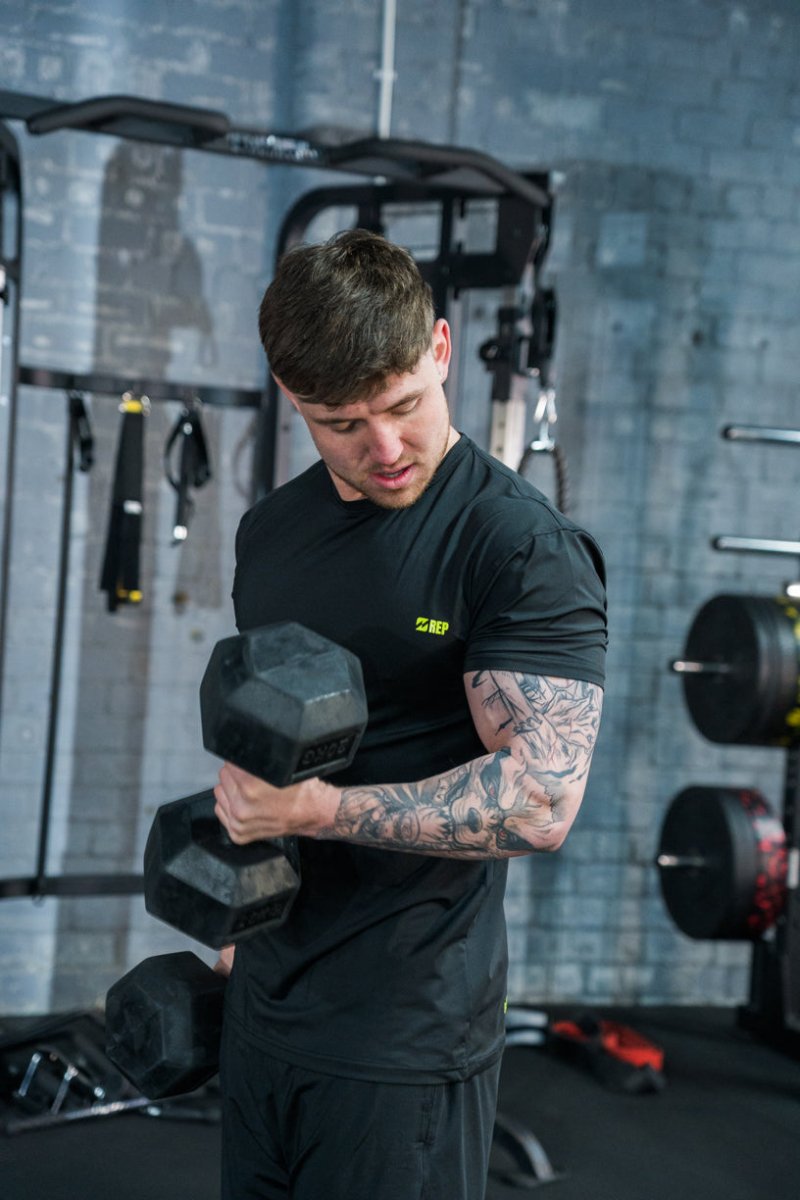![Kettlebell Glute Workout [2025 Guide]](http://repworld.co.uk/cdn/shop/articles/kettlebell-glute-workout-2025-guide-820838.jpg?v=1749559119&width=800)
Kettlebell Glute Workout [2025 Guide]
Glute strength is about more than just looking good in gym shorts. Powerful glutes drive athletic performance, maintain balance, and support injury prevention. Most gym-goers focus on big lifts like deadlifts and squats, but a well-designed kettlebell glute workout can deliver unique benefits you won’t get from barbells alone. Kettlebells mix dynamic movement, core engagement, and unilateral strength, making them brilliant for sculpting glutes that aren’t just strong—they’re functional and explosive.
If you tend to stick to the same leg glute workout week after week, you’re likely missing out on untapped gains. The versatility of kettlebells means you can layer intensity, challenge coordination, and target those deep glute muscles crucial for stability and power. This sets the foundation for every move you make—whether you’re on the pitch, running a 5K, or hammering a HIIT class. The best part? Kettlebells fit easily into home or gym routines, so there are no excuses.
The Science Behind Strong Glutes and Kettlebell Training
To get the most from a kettlebell glute workout, you need to understand how the glutes function. The gluteus maximus, medius, and minimus stabilise your hips, power your stride, and prevent excessive load on knees and lower back. When these muscles are weak or underused, you’re more prone to poor posture, inefficient movement, and even injury.
Kettlebell exercises, such as swings, bridges, and lunges, force the glutes to contract under load and through a wide range of movement. Because kettlebells don’t lock you into a fixed bar path, you recruit more stabilising muscle fibres. Moves like the kettlebell swing activate the posterior chain, building explosive hip drive. This translates to improvements in sprinting, jumping, and heavy lifting.
The British Nutrition Foundation and NHS highlight that regular strength training, including compound lower-body moves, helps protect joints, boosts metabolism, and supports bone health. Kettlebell routines allow you to tick all those boxes while injecting variety into your leg glute workout. For beginners looking to create healthier habits, check the beginner gym workout guide on the REP blog for a strong foundation before starting more advanced movement patterns.
Essential Kettlebell Exercises for Glute Growth and Power
A solid kettlebell glute workout isn’t just about mindlessly swinging a weight. To maximise gains, you need well-constructed exercises that target all areas of the glutes and legs. Here are some tried-and-tested moves to build into your routine, adjustable for all fitness levels.
-
Kettlebell Deadlift
Place the kettlebell between your feet, hinge at the hips, and keep your back straight. Push through your heels and squeeze your glutes at the top. This is a staple for building foundational strength and targeting the posterior chain. -
Kettlebell Swing
The classic swing is a powerhouse for explosive glute drive. Start with the bell in front, hinging at your hips, and explode upward to lift the bell to chest height. Keep your core braced and let your hips, not your arms, drive the movement.

-
Kettlebell Goblet Squat
Hold the kettlebell at your chest, squat low, and keep your knees out. This squat hits glutes, quads, and helps improve squat mechanics. It’s perfect for building muscle and increasing range of motion. -
Single-Leg Romanian Deadlift
Stand on one leg, holding the kettlebell in the opposite hand. Hinge at the hips, lowering the kettlebell as your free leg goes back. This move targets glute medius and minimus, focusing on single-leg strength and balance. -
Kettlebell Hip Thrust
Lie back with your shoulders on a bench, feet on the floor, and a kettlebell resting on your hips. Thrust up, driving through your heels, and squeeze at the top. Hip thrusts recruit the largest glute fibres for maximum tension and growth. -
Curtsy Lunge with Kettlebell
Step one foot diagonally back and across behind the other, holding the kettlebell at chest height. Lean forward slightly as you lower into the lunge. This variation lights up the glute medius and outer thighs.
Combining these exercises into your kettlebell glute workout allows you to hit glutes from every angle. You can scale the intensity by changing rep ranges, adding pauses, or going unilateral to expose weak links. Always focus on quality of movement—rushing reps leads to sloppy form and less muscle activation.
If you’re after a full upper-body challenge, don’t miss these upper body exercises for new ideas on pushing strength across muscle groups.
Kettlebell Glute Workout: Structuring Your Session for Results
How you structure your kettlebell glute workout makes a massive difference in results. Begin with a thorough activation warm-up. Fire up the glutes with bodyweight moves like glute bridges, monster walks, and bodyweight squats. This primes your muscles and mind for heavier work, minimising injury risk. A good warm-up only needs ten minutes but will multiply your gains on every set.
When building your main session, follow a sequence from power-based moves to more isolated or single-leg exercises. Kick things off with swings or deadlifts for max power while you’re fresh. Next, move to bilateral leg movements like goblet squats or hip thrusts for volume and muscle recruitment. Finish off with single-leg Romanian deadlifts or curtsy lunges to iron out imbalances and develop real-world strength.
-
Example Structure:
- Warm-up: 2 sets glute bridges, monster walks, bodyweight squats
- Power lift: 4 sets kettlebell swings (10-15 reps)
- Compound move: 3 sets goblet squats (8-12 reps)
- Hip hinge: 3 sets kettlebell deadlifts (8-12 reps)
- Unilateral: 3 sets single-leg Romanian deadlifts or curtsy lunges (8-10 reps each side)

Rest times should be kept short, around 60-90 seconds, to maintain muscle tension and heart rate. Focus on slow, controlled negatives and a strong squeeze on every rep. Using moderate weights with good technique always beats going heavy with sloppy form.
If you’re new to kettlebell work or returning from a break, drop sets and circuits help build both muscular and cardiovascular endurance. For more ideas on pairing pulling movements with leg work, see these back and biceps workouts for a well-rounded session plan.
Smart Recovery, Progression, and Safety Advice for Kettlebell Leg and Glute Workouts
Your glutes are strong, but they need recovery to grow. After a demanding kettlebell glute workout, avoid training the same muscle group on consecutive days. Instead, aim to leave at least 48 hours between intensive sessions focused on legs and glutes. Use light mobility workouts or low-impact cardio on recovery days.
Progression is the secret to continuous gains. Start with lower weights and higher reps if you’re a beginner, focusing on movement quality. Once you can complete the session with solid form and minimal fatigue, increase the kettlebell weight or add more reps. You can also choose more challenging variations, like pausing at the bottom of a squat or adding pulses to hip thrusts. Always listen to your body—fatigue or sharp pain isn’t normal and might signal an overuse issue.
Safety is non-negotiable. Always keep a neutral spine, avoid rounding your back, and use a weight you can control. If you aren’t sure about proper movement patterns, consider working with a personal trainer or using video guides from reputable sources with expertise in the NHS or British fitness community. Staying hydrated and eating a balanced diet, in line with British Nutrition Foundation guidelines, helps recovery and muscle building. Focus on lean proteins, whole grains, and plenty of vegetables to support progress and keep energy high.
Finally, be consistent. Glute growth and strength come from routine work—not one-off high-intensity sessions. Use variety to challenge your body but stick to the fundamentals. Celebrate small wins: improved movement, more reps, or extra load on a kettlebell. These are markers of growth that go far beyond aesthetics.
Ready to advance your training and build unstoppable lower-body strength? Read more on the REP blog for detailed workouts and expert tips to take your leg glute workout and overall fitness to the next level.
Kettlebell Glute Workout: FAQ's
1. Are kettlebells effective for building glute strength?
Yes, kettlebells are excellent for glute development. They allow for dynamic, compound movements that target the glutes through hip hinging, unilateral work, and explosive lifts like swings. Unlike machines or fixed bar paths, kettlebells challenge stability and coordination, engaging deeper muscle fibers for real-world strength.
2. How often should I train glutes with kettlebells?
Most people benefit from 2–3 focused glute sessions per week using kettlebells. Ensure at least 48 hours of recovery between sessions to allow muscle growth and prevent overtraining. You can include lighter mobility or accessory work on non-strength days.
3. Can beginners do kettlebell glute workouts?
Absolutely. Beginners can start with light weights and basic moves like kettlebell deadlifts, goblet squats, and glute bridges. Focus on mastering form before adding intensity. A gradual approach helps build strength safely and supports long-term progress.
4. What size kettlebell should I use for glute exercises?
For glute-focused exercises, start with 8–12kg (women) or 12–16kg (men), depending on your fitness level. For explosive moves like swings, you may need a heavier bell. Always choose a weight that challenges you without compromising form.
5. How do I structure a kettlebell glute workout for maximum results?
Start with a warm-up to activate glutes, then move into power-based lifts like swings or deadlifts. Follow with compound strength moves (e.g. goblet squats, hip thrusts) and finish with unilateral or isolated glute work. Keep rest periods short and prioritise controlled movement over speed.

![Glute Workout Machine [2025 Guide]](http://repworld.co.uk/cdn/shop/articles/glute-workout-machine-2025-guide-815451.jpg?v=1749559117&width=800)
